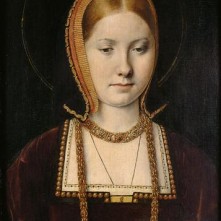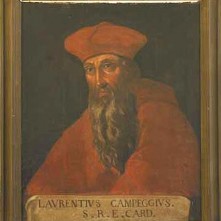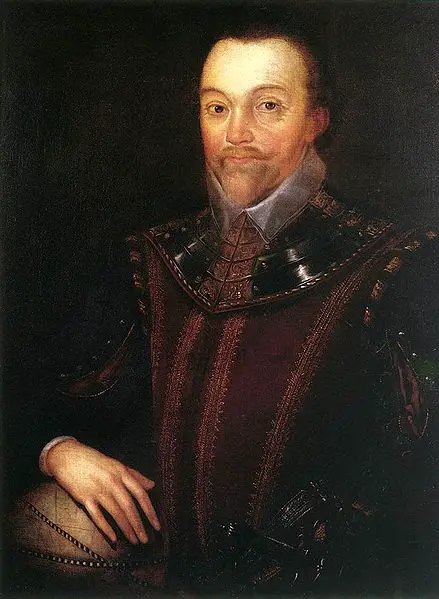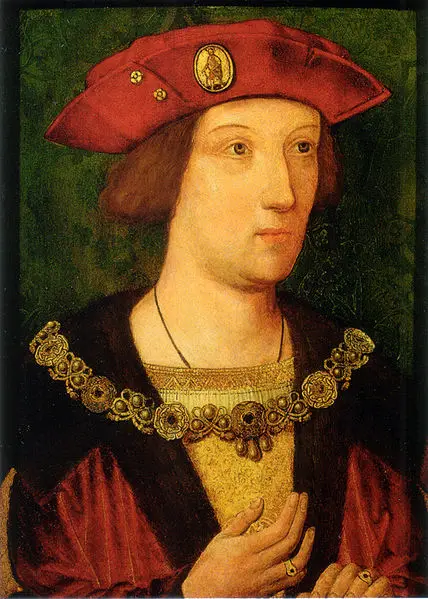26 September
1533 – Death of William Benet, diplomat, at Susa in Italy. He had been appointed Henry VIII's Resident Ambassador to Rome in 1529 and remained in that position until the break with Rome. He was on his way home from Rome when he died.
1555 – Death of Thomas Berthelet, printer, in London. Berthelet had been Henry VIII's printer from 1530 until the King's death in 1547.
1580 - Sir Francis Drake arrived at the port of Plymouth in the Golden Hind, which was laden with treasure and spices after his three year voyage around the world. Drake was the first Englishman to circumnavigate the globe, and was rewarded by Queen Elizabeth I with a knighthood on 4th April 1581, aboard the Golden Hind at Deptford.
1588 – Death of Sir Amias (Amyas) Paulet, administrator, diplomat, Governor of Jersey and gaoler of Mary, Queen of Scots. He was buried in St Martin-in-the-Fields, Westminster. Paulet served Elizabeth I as her resident ambassador in France and a Privy Councillor, and was present at the execution of Mary, Queen of Scots. When he was acting as Mary's gaoler, Elizabeth I had suggested that it would be easier if Paulet quietly murdered her. He refused.
1592 – Burial of Thomas Watson, poet and translator, at St Bartholomew-the-Less. Watson is known for his unusual eighteen line sonnets and his Latin works.
1595 – Burial of Sir Owen Hopton, administrator and politician, at St Dunstan's Church, Stepney. Hopton served Elizabeth I as Lieutenant of the Tower of London from 1570-1590, as a member of Parliament and a Sheriff.
27 September
 1442 – Birth of John de la Pole, 2nd Duke of Suffolk, to William de la Pole, 1st Duke of Suffolk, and his wife Alice (née Chaucer). Suffolk married the six year-old Margaret Beaufort, future mother of Henry VII, in 1449, but the marriage was annulled by Henry VI in 1453, and he went on to marry Elizabeth, daughter of Richard of York and sister of Edward IV.
1442 – Birth of John de la Pole, 2nd Duke of Suffolk, to William de la Pole, 1st Duke of Suffolk, and his wife Alice (née Chaucer). Suffolk married the six year-old Margaret Beaufort, future mother of Henry VII, in 1449, but the marriage was annulled by Henry VI in 1453, and he went on to marry Elizabeth, daughter of Richard of York and sister of Edward IV.
1488 – Death of William Hobbes, physician and surgeon. He was buried in Holy Trinity Priory, Aldgate, London. Hobbes served Richard, Duke of York, and Edward IV, and was Royal Physician to Richard III. He became Master of St Mary of Bethlehem Hospital (Bedlam) in 1479.
1501 - Fifteen year-old Catherine of Aragon left the port of Laredo in Spain bound for England to marry Arthur, Prince of Wales. It was her second attempt at sailing from Spain to England. Her first attempt, on 17th August, from A Coruña, had been a failure: strong storms in the notoriously rough Bay of Biscay had forced Catherine's fleet to land at Laredo, near Bilbao. She landed at Plymouth on 2nd October.
1540 – Birth of Michael Heneage, politician and antiquary. Heneage was a member of Parliament, a Keeper of the Records in the Tower of London, and a member of the Society of Antiquaries.
1571 – Death of Sir William Garrard, merchant, in London. He was buried in the church of of St Magnus the Martyr near London Bridge. Garrard was Mayor of London in 1555, and a member of Parliament during Mary I's reign. He also went on voyages to Guinea in the 1550s and 1560s, and became a consul of the Russia Company in 1553.
28 September
1502 – Death of Robert Willoughby, 1st Baron Willoughby de Broke, at Callington, Cornwall. He was buried at Callington Church. Willoughby had been in exile in Brittany with Henry Tudor and fought with him at the Battle of Bosworth. He served Henry VII as Lord Steward and was made a Knight of the Garter in 1489.
1553 - Mary I travelled in a decorated barge to the Tower of London to prepare for her coronation. She was accompanied by her half-sister, Elizabeth.
1558 (28th or 29th) – Death of Sir Robert Acton, Royal Saddler and member of Parliament. He was buried in Elmley Lovett church. Acton also served as a Justice of the Peace and Sheriff during Henry VIII's reign, as well as being on the council in the marches of Wales. As Royal Saddler, he went with the King to Boulogne in 1544.
1560 – Death of Francis Talbot, 5th Earl of Shrewsbury, at Sheffield. He was buried at St Peter's Church, Sheffield, which is now the cathedral.
1582 – Death of George Buchanan, Scottish historian, humanist scholar and poet. He was buried in Greyfriars churchyard in Edinburgh. His works included his 1579 “History of Scotland” (Rerum Scoticarum Historia), the 1579 treatise De Jure Regni apud Scotos, his satire “Chamaeleon” and his poems.
1594 – Death of John Piers, Archbishop of York, at his home, Bishopthorpe. He was aged seventy-one. Piers was buried at York Minster.
1599 – Robert Devereux, 2nd Earl of Essex, strode into Elizabeth I's bedchamber unannounced and saw the Queen without her makeup or wig, without her “mask of youth”.
29 September
1528 – The papal legate, Cardinal Lorenzo Campeggio, landed at Dover on the Kent coast. He had arrived in preparation for hearing the case for the annulment of the marriage of Henry VIII and Catherine of Aragon at a special legatine court.
1553 – Mary I created fifteen Knights of the Bath as part of her coronation celebrations.
1558 – Death of George Brooke, 9th Baron Cobham, soldier and landowner. He was buried at Cobham Church. Cobham acted as Lieutenant-General in spring 1544 when English forces invaded Scotland, and was made Deputy of Calais in June 1544. He was created a Knight of the Garter in 1549, and was on Edward VI's Privy Council. He was imprisoned in the Tower of London temporarily in 1554 after being implicated in Wyatt's Rebellion, but was released and fined.
1564 - Robert Dudley was made Earl of Leicester, an earldom which had been planned earlier in the year to make him more acceptable as a bridegroom to Mary, Queen of Scots.
30 September
1515 – Margaret Tudor, sister of Henry VIII and former Queen Consort of James IV, fled to England. Margaret was pregnant with the child of her new husband, Archibald Douglas, 6th Earl of Angus. John Stewart, 2nd Earl of Albany, was acting as Regent for Margaret's son, the young James V, and had custody of the boy and his brother, Alexander.
1544 – Henry VIII returned to England after his victory in Boulogne. The French forces had surrendered on 13th September after a siege which lasted from 19th July.
1546 – Death of Sir Richard Long, member of Parliament and gentleman of Henry VIII's privy chamber.
1553 - Mary I's coronation procession from the Tower of London to Whitehall.
1585 – Philip Howard, Earl of Arundel and son of Thomas Howard, 4th Duke of Norfolk, was received into the Catholic Church by Jesuit William Weston at Arundel Castle.
1 October
1500 – Death of John Alc*ck, Bishop of Ely, scholar and Royal Tutor, at Wisbech Castle. He was buried at Ely Cathedral, in the chantry chapel he had designed. Alc*ck had acted as tutor to Prince Edward, son of Edward IV, and had also been president of the Prince's Council at Ludlow. He was also Henry VII's first Chancellor and opened his first Parliament.
1505 – Death of Sir Henry Colet, merchant and Lord Mayor of London, at Stepney. He was buried there.
1526 – Birth of Dorothy Stafford, Lady Stafford, daughter of Henry Stafford, 10th Baron Stafford, and his wife, Ursula (née Pole). Dorothy married Sir William Stafford, widower of Mary Boleyn, in 1545. She served Elizabeth I as a gentlewoman of the Privy Chamber.
1553 - Mary I was crowned Queen at Westminster Abbey by Stephen Gardiner, the Bishop of Winchester.
2 October
1452 - Richard III, the last Plantagenet king, was born at Fotheringhay Castle, Northamptonshire. Richard was the youngest surviving child of Richard, 3rd Duke of York, and Cecily Neville. Richard claimed the English throne in June 1483, claiming that his brother Edward IV’s sons were illegitimate because Edward had been pre-contracted to another woman when he married Elizabeth Woodville. Richard III was killed at the Battle of Bosworth on 22nd August 1485, and Henry Tudor claimed the throne as Henry VII.
1501 – Catherine of Aragon arrived in England, landing at Plymouth in Devon. She had come to England to marry Prince Arthur, the heir to the throne of England.
1514 – Mary Tudor, sister of Henry VIII, set off from Dover to sail to France to marry King Louis XII. She was eighteen and he was fifty-two, and not in the best of health. They married on 9th October 1514, but the marriage was short-lived as Louis died in January 1515. Mary went on to marry Charles Brandon, the Duke of Suffolk, on the 3rd March 1515.
1518 – Treaty of London – Cardinal Wolsey’s treaty of “Universal” peace between France and England was signed.
1521 – Pope Leo X was given Henry VIII’s Assertio septem sacramentorum or “Defence of the Seven Sacraments” in Rome. This work led to Henry VIII being proclaimed Fidei Defensor or “Defender of the Faith”.
1528 – Publication of William Tyndale’s “The Obedience of the Christian Man and How Christian Rulers Ought to Govern”.
1536 – Start of the Lincolnshire Rising, the beginning of the Pilgrimage of Grace. It was sparked off by a sermon at evensong on the 1st October at St James’s Church, Louth, and by a visitation from a registrar on 2nd October.








Cannot wait for Sunday 2nd the birthday of our good King Richard as there are special musical celebrations at Middleham with a link on the website. I know he was born at Fotheringhay were in the church are special services as well.
Happy Birthday King Richard lll born 564 years today 1452 at Fotheringhay Castle. Our new standard is flying today also at his and Anne Nevilles Home in Middleham Castle. Loyalty Binds Me!!!! YNWA